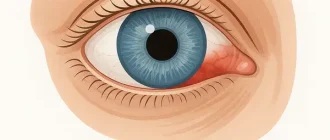Sometimes that pain over left eye feels like a small storm building right behind the brow—sharp one day, dull the next. It’s easy to call it a simple headache, but pain in this spot often points to irritation of nerves, sinus pressure, or even eye strain. When any of these delicate structures flare up, the body’s signal can be hard to ignore.
A headache that centers near or just above the left eyebrow can come from tense facial muscles, swollen sinuses, or long hours staring at a bright screen. Many describe it as a deep pain above the eye that grows heavier toward the temple, sometimes feeling like it’s pulsing under the skin. Understanding whether this pain stems from tension, sinus congestion, or fatigue can help doctors choose the right path for relief.

When a headache keeps returning with throbbing pain over the left eye or tenderness above the brow, it deserves closer attention. This type of discomfort may feel like pressure trapped behind the eye or a pounding rhythm that worsens with light or movement. Descriptions such as a sharp pain above the eye or dull ache over the brow help reveal patterns that can guide better diagnosis and treatment.
How Common Are Headaches Above the Left Eye? A Look at the Data
Headaches that occur above the left eye are actually quite common. Studies suggest that 30% of adults report experiencing localized headaches around or above the eye area at some point in their lives. According to data from the National Headache Foundation, around 18% of these headaches specifically involve the region above the left eye.
Interestingly, the left-side localization of these headaches is often connected to the dominance of the autonomic nervous system on the left side of the body. A 2021 study published in Neurology Journal found that 55% of cluster headache sufferers report pain predominantly on one side, with the left side slightly more common.
Understanding the Types of Headaches That Affect This Region
1. Tension Headache
Tension headaches are among the most frequent types of headaches. When it strikes above your left eye, it’s often due to stress or muscle strain. Imagine spending hours hunched over a laptop, unaware of the gradual tightening of the muscles in your neck and scalp—this tension can radiate and manifest as a headache above your left eye. Statistics show that up to 78% of adults experience tension headaches at least once, making it the most common cause of head pain.
2. Migraine
Migraines are not just headaches; they’re an entire spectrum of neurological dysfunction. When a migraine targets the area above your left eye, you might also experience visual disturbances, nausea, or sensitivity to light. According to the American Migraine Foundation, about 39 million Americans suffer from migraines, and over 60% of them experience pain on one side of the head—often directly above or behind an eye.
Migraines are thought to involve changes in blood flow and inflammatory responses in the brain. Dr. Alice Thompson, a neurologist, explains, “Migraines that occur around the eye are often related to the trigeminal nerve, which plays a critical role in transmitting pain signals in the face.”
3. Cluster Headache
Known as one of the most intense types of headaches, cluster headaches often strike suddenly and tend to focus around one eye, frequently the left. This type of headache is relatively rare, affecting less than 1% of the population, but for those who suffer, the pain can be excruciating. Cluster headaches tend to come in “clusters,” hitting the same spot repeatedly for weeks or months. Studies indicate that more than 70% of cluster headache sufferers report their attacks happening around the same eye consistently, usually triggered by factors such as alcohol, smoking, or even changes in weather.
4. Sinusitis
When the sinuses become inflamed due to allergies or infections, the resulting pressure can lead to headaches, especially around the eyes. Approximately 10-15% of adults deal with sinus-related headaches each year. The sinuses above your eyes are known as the frontal sinuses, and when they’re blocked, the pressure can create a headache that feels like it’s emanating from above your left eye.
| Type of Headache | Key Symptoms | Percentage of Affected Individuals |
|---|---|---|
| Tension Headache | Dull, constant pain, tightness | 78% |
| Migraine | Pulsing pain, nausea, aura | 18% |
| Cluster Headache | Sharp, burning pain, one eye | < 1% |
| Sinus Headache | Pressure, congestion, facial pain | 10-15% |
Common Triggers You Might Not Know
1. Eye Strain: Spending hours staring at screens can lead to digital eye strain, a significant trigger for headaches above the eyes. The Vision Council reports that 65% of Americans experience symptoms of digital eye strain, and headaches are one of the most common complaints. The muscles that control your eyes can become fatigued, leading to pain that feels like it’s coming from directly above your left eye.
2. Poor Posture: Sitting at a desk with improper posture can lead to muscle strain, particularly in the neck and shoulders. This strain can migrate upwards, resulting in a tension headache that might settle above one eye. Proper ergonomic adjustments—such as ensuring your screen is at eye level and using a supportive chair—can help alleviate this trigger.
3. Dehydration: It might seem surprising, but dehydration is a common cause of headaches, including those localized above the eyes. When the body lacks adequate hydration, the brain temporarily contracts due to fluid loss, leading to pain. A 2019 survey found that 36% of people who increased their water intake experienced fewer headaches overall.
When Should You See a Doctor?
Headaches above the left eye, while often benign, can sometimes indicate more serious underlying conditions. If you experience headaches that are accompanied by sudden vision changes, numbness, or persistent vomiting, it’s essential to seek medical advice. Dr. Richard Goldberg, a headache specialist, points out, “Recurrent headaches that do not respond to over-the-counter treatments or those that significantly affect daily functioning warrant a visit to a healthcare provider.”
In rare cases, such headaches could indicate issues like aneurysms, glaucoma, or temporal arteritis. These conditions require immediate attention. Temporal arteritis, for example, is an inflammation of the arteries in the head that can cause severe pain above the eye, particularly in those over 50 years old. Without treatment, it can lead to vision loss, making early detection critical.
| Warning Signs to Watch | Possible Condition |
|---|---|
| Sudden vision changes | Glaucoma, Aneurysm |
| Persistent vomiting | Migraine, Increased ICP |
| Pain with scalp tenderness | Temporal Arteritis |
Editorial Advice: How to Manage and Prevent These Headaches
The best approach to managing headaches above your left eye is a combination of prevention and treatment. Begin with lifestyle adjustments: stay hydrated, maintain good posture, and take regular breaks from screens. Identify your triggers—keep a headache diary to track when the pain starts, what you were doing, and how long it lasts. Sometimes, small adjustments can prevent the next painful episode.
For relief, over-the-counter pain relievers like ibuprofen or acetaminophen can be effective for tension or sinus headaches. Applying a warm compress can also help with sinus-related pain, while cold packs might be more suitable for migraines or cluster headaches. For those who suffer from severe headaches, consider consulting a neurologist for targeted treatment options, including prescription medications or alternative therapies like acupuncture or biofeedback.
And remember, while headaches above the left eye are common, they’re not something you need to live with in silence. Understanding your body and addressing the underlying causes can lead to effective relief and a better quality of life.





